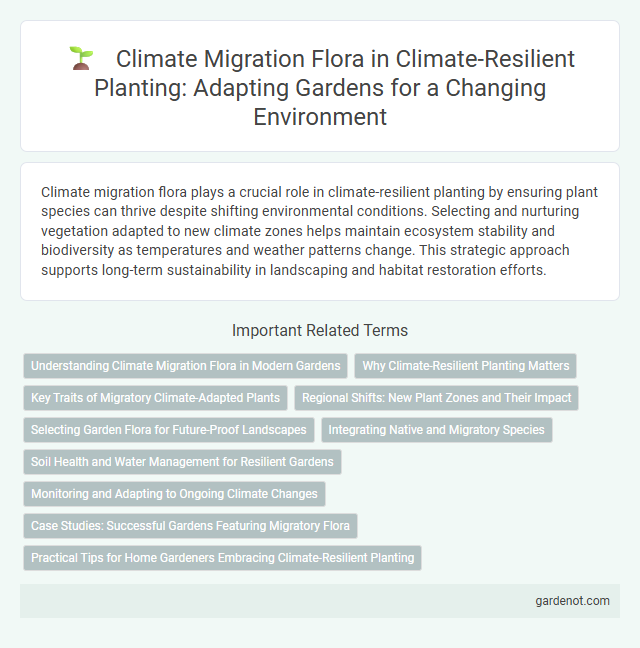Climate migration flora plays a crucial role in climate-resilient planting by ensuring plant species can thrive despite shifting environmental conditions. Selecting and nurturing vegetation adapted to new climate zones helps maintain ecosystem stability and biodiversity as temperatures and weather patterns change. This strategic approach supports long-term sustainability in landscaping and habitat restoration efforts.
Understanding Climate Migration Flora in Modern Gardens
Climate migration flora refers to plant species that shift their natural ranges in response to changing climate conditions, making them vital in modern gardens designed for resilience. These species often thrive in environments that mimic future climate scenarios, offering gardeners adaptive options to sustain biodiversity and ecosystem services. Incorporating climate migration flora into garden planning ensures long-term plant survival and supports habitat connectivity amid shifting temperature and precipitation patterns.
Why Climate-Resilient Planting Matters
Climate-resilient planting addresses the challenge of climate migration by selecting flora capable of thriving under shifting temperature and precipitation patterns. This approach preserves biodiversity and supports ecosystem stability amid environmental stressors linked to climate change. Implementing climate-resilient vegetation enhances carbon sequestration and safeguards habitats crucial for both wildlife and human communities facing climate displacement.
Key Traits of Migratory Climate-Adapted Plants
Migratory climate-adapted plants exhibit key traits such as drought tolerance, rapid phenological shifts, and high genetic diversity, enabling them to survive and reproduce under changing climatic conditions. Their deep root systems enhance water acquisition during prolonged dry periods, while phenotypic plasticity allows adjustment to variable temperature and precipitation patterns. These adaptive traits collectively support ecosystem stability and facilitate species migration in response to climate shifts.
Regional Shifts: New Plant Zones and Their Impact
Climate migration flora is reshaping ecosystems as regional shifts create new plant zones, significantly altering biodiversity patterns and agricultural viability. These changes demand adaptive management strategies to support climate-resilient planting by selecting species better suited to emerging environmental conditions. Understanding these shifts enables improved forecasting of plant distribution and helps mitigate the effects of climate change on vegetation productivity.
Selecting Garden Flora for Future-Proof Landscapes
Selecting garden flora that thrives amid shifting climate conditions is essential for future-proof landscapes, emphasizing drought-tolerant, heat-resilient, and native species. Incorporating plants with deep root systems enhances soil stability and water retention, reducing vulnerability to extreme weather events. Prioritizing biodiversity with climate migration flora ensures adaptability and ecological balance in garden ecosystems facing unpredictable climate patterns.
Integrating Native and Migratory Species
Integrating native and migratory species in climate-resilient planting enhances ecosystem adaptability and biodiversity, supporting both local flora and species shifting ranges due to climate change. Native plants provide essential habitat stability and soil health benefits, while migratory species contribute genetic diversity and resilience against evolving environmental stresses. Strategic selection and planting of these combined species promote sustainable landscapes that can better withstand climate-induced shifts and assist in mitigating climate migration impacts on ecosystems.
Soil Health and Water Management for Resilient Gardens
Climate migration flora thrives by enhancing soil health through increased organic matter and microbial activity, which improves nutrient cycling and water retention. Effective water management techniques, such as drip irrigation and rainwater harvesting, optimize moisture availability while minimizing water waste. Integrating diverse, climate-adapted plants supports ecosystem stability and resilience in changing environmental conditions.
Monitoring and Adapting to Ongoing Climate Changes
Climate migration flora requires continuous monitoring of temperature shifts, precipitation patterns, and soil moisture to assess plant resilience. Adaptive management strategies involve selecting species with high phenotypic plasticity and using remote sensing technologies to track vegetation health. Integrating climate models with real-time data enables dynamic adjustments in planting schedules and species composition to enhance ecosystem stability.
Case Studies: Successful Gardens Featuring Migratory Flora
Case studies of successful gardens featuring climate migration flora demonstrate how adaptive planting strategies enhance ecosystem resilience against climate change impacts. Gardens such as the Chicago Botanic Garden and Royal Botanic Garden Edinburgh showcase diverse species migrated from warmer climates, promoting biodiversity and soil stabilization. These projects provide valuable data on species survival rates, phenological shifts, and habitat integration under evolving climatic conditions.
Practical Tips for Home Gardeners Embracing Climate-Resilient Planting
Home gardeners can enhance climate resilience by selecting native and drought-tolerant plants that adapt well to shifting environmental conditions and reduce water usage. Incorporating mulching techniques and soil amendments improves moisture retention and supports plant health during extreme weather events. Regular monitoring of soil moisture and adjusting planting schedules help mitigate the impacts of temperature fluctuations and unpredictable rainfall patterns.
Climate migration flora Infographic

 gardenot.com
gardenot.com